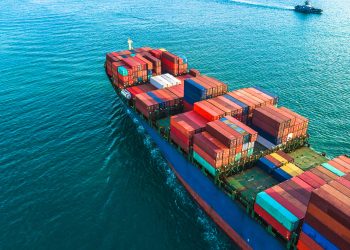Container feederships are containerships which carry cargo to and from the main “hub” ports
 Container feederships are containerships which carry cargo to and from the main “hub” ports served by the large deep-sea vessels around the network of secondary ports and terminals which the main line ships would be unable to reach on account of their size. They are an important link in the logistics chain in that they enable cargo to travel as long as possible in the most economic and environmentally sustainable way – by sea. In the past, many feeders were main line ships that had been displaced from their deep sea routes by larger vessels, but which had plenty of useful life left in them. Specialist feederships have evolved over the years to provide the most efficient carriage of containers.
Container feederships are containerships which carry cargo to and from the main “hub” ports served by the large deep-sea vessels around the network of secondary ports and terminals which the main line ships would be unable to reach on account of their size. They are an important link in the logistics chain in that they enable cargo to travel as long as possible in the most economic and environmentally sustainable way – by sea. In the past, many feeders were main line ships that had been displaced from their deep sea routes by larger vessels, but which had plenty of useful life left in them. Specialist feederships have evolved over the years to provide the most efficient carriage of containers.
Much will depend upon the routes these smaller containerships are designed to serve. In North Europe, many of the secondary ports have their own container handling gantries, so gearless ships (those without their own deck cranes) will be employed. In the South East Asian and East Asian container trades, while the ships will usually be handled at the hub ports by the high speed shiploading gantries, in secondary ports they may be required to use their own deck cranes. Modern ships would typically have their own 25 tonne cranes offset on one side of the ship, so that they do not obstruct shore equipment in the hub ports.
The time that a container spends at the terminals between the mainline ship and its distributing feeder vessel needs to be minimised so that the total voyage is not appreciably longer that that aboard a direct sailing (if this was possible). The feeder operations need to be fast and efficient, the ships handy and manoeuvrable, with a reasonable draught, so that no waiting for tides is required. Some modern feederships are designed so that they do not need hatchcovers, so that there are no delays in lifting these ashore and shipping them again. A new consideration is that feederships will be vessels on short voyages, possibly spending much of their time within Emission Control Areas, so that their fuel efficiency will be crucial if more expensive low sulphur fuels have to be burned. Charterers of these ships will be impressed by both their efficiency and their low environmental footprint.
There are some notably advanced designs entering service; vessels with streamlined bows and a profile designed to facilitate fast cargo handling. These are intensively operated vessels so it is important that they have optimum stability, an ability to move ballast around fast to maintain the right trim and heel when handling cargo, and plenty of space for the safe stowage of containers on high deck stacks. While traditionally the superstructure has been right aft, more ships have been designed with this on the forecastle, and a new design now attracting attention features the superstructure close to the mid-length.
Source :BIMCO





























































